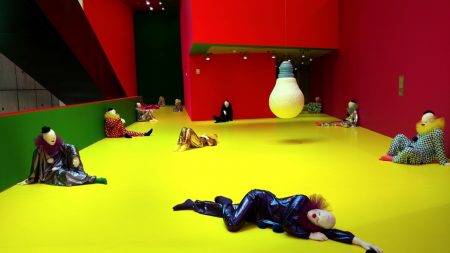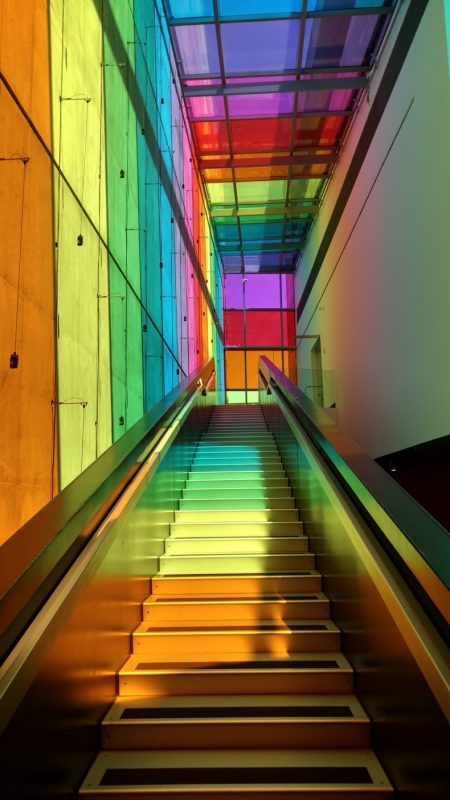
Ugo Rondinone, born and based in Switzerland, is known for sculptures and installations with alternately an absence or an overabundance of color. Referred to by the artist quite literally as “night” and “day,” one oeuvre contains mostly greys, browns, and earth tones while the other—what’s on view now at the CAC—a vibrant spectrum of bright, artificial color. Rainbows echoing the pride flag have filled the galleries and adorned the exteriors of institutions the world over, and along with last summer’s Do Ho Suh exhibition, let’s start this day again, the latest presentation of Rondinone’s multicolor oeuvre, positions the Contemporary Arts Center within an international group of institutions. Rondinone’s spectrum of color completely overtakes the top floors of Zaha Hadid’s iconic building in downtown Cincinnati, and I find the site-specific components of this exhibition to be its strengths—Hadid’s dramatic diagonals form a Constructivist composition of pure color and the rainbow-tinted skylights flood the walls and stairs. Covering the ceiling skylight and nearly every inch of the third and fourth floors with Rondinone’s signature color spectrum was no small undertaking, and CAC was the first institution that featured colored floors as well as walls. Many of the artworks housed within Rondinone’s painted rooms, however, were underwhelming, sparse, and unable to compete with their funhouse surroundings.
On the first floor are the most photographed members of the exhibition—life-sized casts of clowns strewn about like revelers at the end of an orgy. Together the forty-five clowns form the work vocabulary of solitude (2014). Each sculpture is life-cast from a real person and subtitled with daily activities ranging from the physical (Pee, Shit, Eat) to the psychological and spiritual (Love, Lie, Hope). Despite the unique individual cast to make each work, they initially appear uniform and lacking individual identity. The figure of the clown seems almost incapable of evoking the happiness and joy he ostensibly represents—many people report being afraid of clowns, and they have long signified sadness and hidden identities in art history. Picasso returned repeatedly to the character of the harlequin, for example, and since the 1990s Rondinone has used the clown as a surrogate for himself and the artist’s inner and outer life.
Placed in a variety of positions and group arrangements throughout the CAC’s third floor, one anticipates new interactions and discursive spaces to pop up between the clowns, and indeed each one appears as if it could start moving at any moment (a creepy effect, to say the least). The closed eyes of the masks and introspective poses keep them from interacting, however, and it is hard to discern how each titled action corresponds to each clown—they all just look tired. The clown masks intentionally show signs of wear, and the painted floor similarly bears the skids from shoes of gallery visitors, despite the CAC’s placement of a sticky mat at the entrance to prevent visitors from marking the floor. Far from prompting my own sense of introspection, the figures instead evoked a sense of dread, hinting at but not revealing any details of what catastrophic event occurred just before the hangover I walked into. The headache-inducing colors furthered this sense of discomfort, and the contrast between the clowns’ joyful clothing and somber comportment rendered the work unsettling.

Rondinone’s other sculptures were sparsely placed, mostly on the floor above the clowns, and muted by their colorful surroundings. A wax sculpture of a light bulb appeared dull compared to the electric intensity of its surrounding colors, oversized and hand-sewn red clown shoes hung all alone on a bright blue wall, and painted bronze sculptures of melted wax candles were almost unnoticeable on one of the only white floors in the nearly empty galleries on the CAC’s fourth floor. Though subtle plays of traditional craft, materials, and medium, these sculptures could neither transcend nor coalesce with the highlighter-bright tones surrounding them. The diversity and visual interest created by your age and my age and the age of the rainbow (2014), a wall-length collage of children’s drawings of rainbows from the artist’s collaboration with Cincinnati schools, contrasted sharply with the sparse presentation throughout the rest of the floor.
One of the earlier pieces in the exhibition, ersternovemberneunzehnhundertachtundneunzig (1998), contained an optical intensity to match its surroundings. Large concentric rings generated a mesmerizing optical effect that was amplified by the safety cone orange behind it. As I moved in all directions the painting appeared to pulsate, evoking the sensation of looking at the sun. Even reading the label became an optically vibrating sensation. This painting is part of a longer series of sun paintings derived from small watercolors the artist completed in his native Switzerland while looking at the sun. Enlarged and titled after the date of observation, these works combine a diaristic, romantic observation of nature derived from Goethe with the scale of Kenneth Noland and the optical effects of Bridget Riley.
The show’s saving grace was its connection to the CAC’s architecture. Zaha Hadid’s building is already a unique aesthetic experience on its own, and the dizzyingly bright and contrasting colors of Rondinone’s installation amplified the dramatic diagonals of the space. Walking around the exhibition created new compositions of color that were often more interesting than the sculptures on display. The successful collaboration between architecture and color is most successful in the building’s iconic stairways. A rainbow of tinted windows, the piece love invents us (1999), is particularly striking in the CAC’s skylights, painting the walls with light and transforming the procession up the stairs. The pendulums from Erwin Redl’s permanent site-specific installation Cincinnati Swing (2015) are static on the floors of Rondinone’s exhibition, making the sun’s passage through fields of color the most significant animation in the space. The at times nauseating feeling in the gallery spaces of being inside an optically vibrating field of artificial color melts away in the staircase, a reprieve that perhaps owes as much to the building as to Rondinone’s intervention.
–Annie Dell’Aria